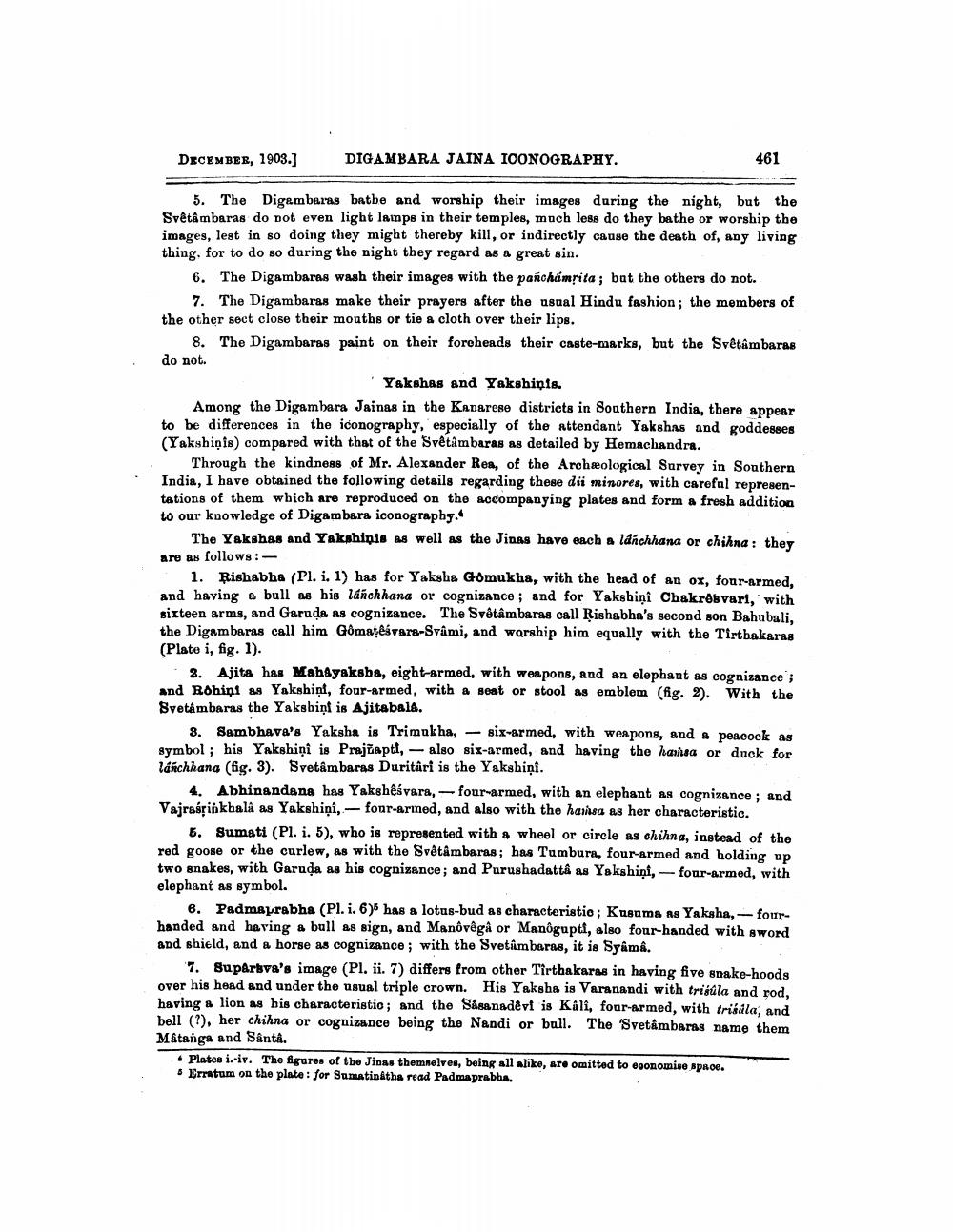________________
DECEMBER, 1903.)
DIGAMBARA JAINA ICONOGRAPHY.
461
5. The Digambaras batbe and worship their images during the night, but the Svêtâmbaras do not even light lamps in their temples, much less do they bathe or worship the images, lest in so doing they might thereby kill, or indirectly cause the death of, any living thing, for to do so during the night they regard as a great sin.
6. The Digambaras wash their images with the pañchúmrita ; bat the others do not.
7. The Digambaras make their prayers after the usual Hindu fashion; the members of the other sect close their mouths or tie a cloth over their lips.
8. The Digambaras paint on their foreheads their caste-marks, but the Svêtâmbaras do not.
Yakshas and Yakshinis. Among the Digambara Jainas in the Kadarese districts in Southern India, there appear to be differences in the iconography, especially of the attendant Yakshas and goddesses (Yakshiņis) compared with that of the Svetambaras as detailed by Hemachandra.
Through the kindness of Mr. Alexander Res, of the Archeological Survey in Southern India, I have obtained the following details regarding these dii minores, with careful representations of them which are reproduced on the accompanying plates and form a fresh addition to our knowledge of Digambara iconography.
The Yakshas and Yakshiņis as well as the Jinas have each a láńchhana or chihna : they are as follows:
1. Rishabha (Pl. i. 1) has for Yaksha Gomukha, with the head of an ox, four-armed, and having a bull as his lánchhana or cognizance; and for Yakshiņi Chakrobvart,' with sixteen arms, and Garuda as cognizance. The Svêtâmbaras call Rishabha's second son Bahubali, the Digambaras call him Gómatesvara-Svami, and worship him equally with the Tirthakaras (Plate i, fig. 1).
• 2. Ajita has Mahayaksba, eight-armed, with weapons, and an elephant as cognizance ; and Bohint as Yakshini, four-armed, with a sest or stool as emblem (fig. 2). With the Svetambaras the Yakshiņf is Ajitabala.
8. Sambhava's Yaksha is Trimukha, - six-armed, with weapons, and peacock as gymbol ; his Yakshiņi is Prajiapti, - also six-armed, and having the haisa or duck for láhchhana (fig. 3). Svetâmbaras Duritari is the Yakshiņi.
4. Abhinandana has Yakghệávara, -four-armed, with an elephant as cognizance; and Vajraériákbal as Yakshini,- four-armed, and also with the hashsa as her characteristic.
6. Sumati (Pl. i. 5), who is represented with a wheel or circle as chihna, instead of the red goose or the curlew, as with the Svêtâmbaras; has Tumbura, four-armed and holding up two snakes, with Garuda as his cognizance; and Purushadattâ as Yakshiņi, -four-armed, with elephant as symbol.
8. Padmaprabha (Pl. i. 6)6 has a lotus-bud as characteristio ; Kusuma As Yaksha, -fourhanded and having a bull as sign, and Manövêga or Manôgupti, also four-handed with sword and shield, and a horse as cognizance; with the Svetambaras, it is Syami.
7. Suparava's image (Pl. ii. 7) differs from other Tirthakaras in having five snake-hoods over his head and under the usual triple crown. His Yaksha is Varanandi with trisula and rod, having a lion as his characteristio ; and the Såsanadêvf is Kali, four-armed, with tribila, and bell (?), her chihna or cognizance being the Nandi or ball. The 'Svetâmbaras name them Matanga and Santâ.
. Plates i.-iv. The figures of the Jinss themselves, being all alike, are omitted to economise sproe.
Erratum on the plate: for Sumatinátha read Padmaprabha.




